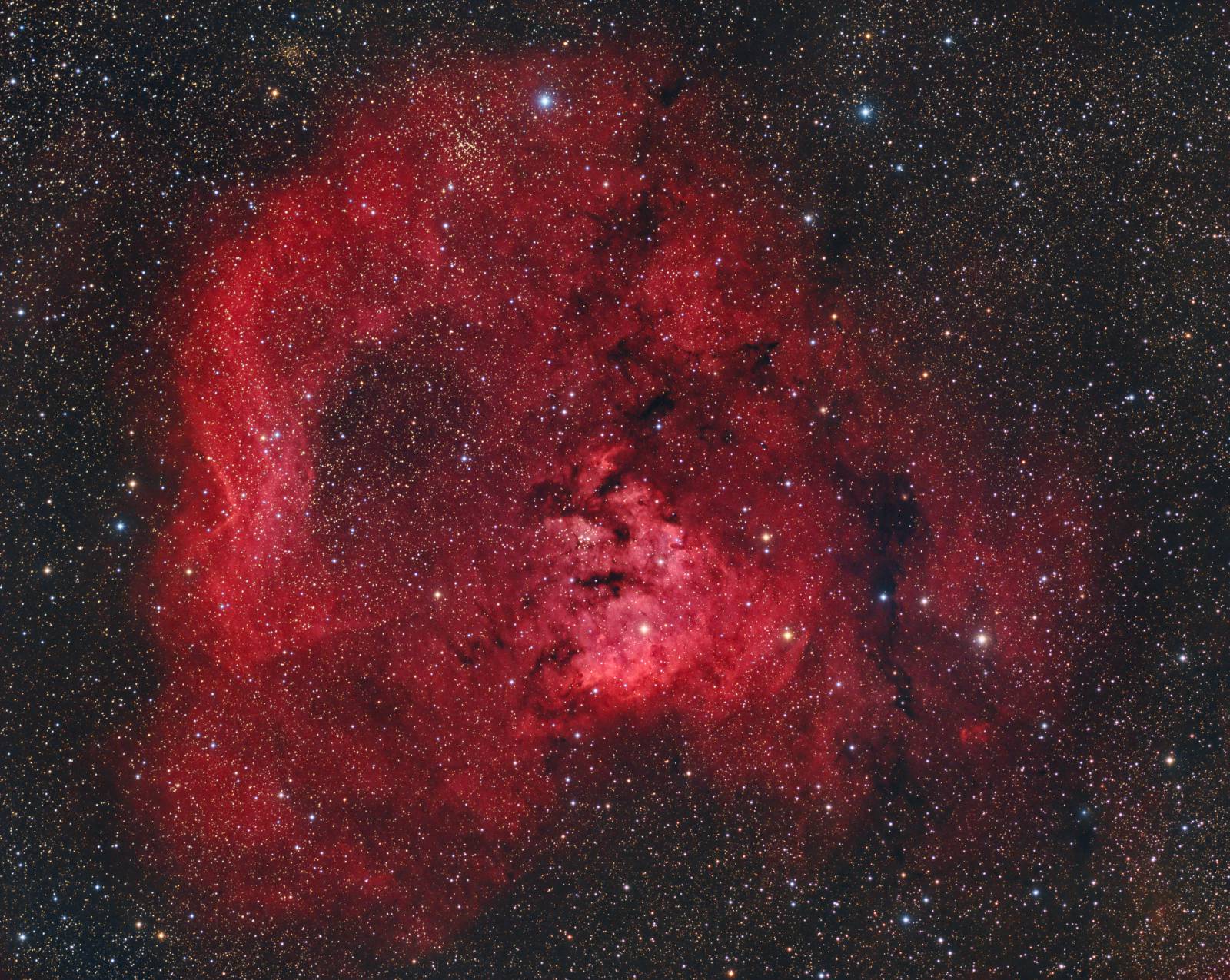NGC7822 Region
 Click image for full size version
Click image for full size version
January 16, 2017, Amateur Astronomy Picture of the Day Sept 7, 2017
 There’s a lot going on this image! NGC7822 is the bright patch near the centre, and it is surrounded by Sh2-171. Near top centre, within the nebula, is open cluster NGC7762. Above and to its left is open cluster King 11. Another open cluster, Berkeley 59 is very near the centre of this image, in the brightest part of the nebula.
There’s a lot going on this image! NGC7822 is the bright patch near the centre, and it is surrounded by Sh2-171. Near top centre, within the nebula, is open cluster NGC7762. Above and to its left is open cluster King 11. Another open cluster, Berkeley 59 is very near the centre of this image, in the brightest part of the nebula.
This emission nebula complex lies around 2,500-3,200 light years from earth. The glowing gas is mostly hydrogen but the brightest areas also have oxygen-3 emissions.
NGC7822 is also known as Cederblad 214, and I have imaged it at higher resolution previously.
Tekkies:
Moravian G3-16200 EC camera (on loan from O’Telescope), Optolong Ha, O3, R, G and B filters, Takahashi FSQ-106 ED IV at f/3.6, Paramount MX, QHY5 guide camera, 175mm f.l. guide scope. Acquisition with the SkyX, focused with FocusMax. All pre-processing and processing in PixInsight. Acquired from my SkyShed in Guelph. Gibbous moon for Ha and O3, crescent moon for RGB, average transparency and seeing.
14x10m R, G and B; 12x20m Ha and 6x20m O3 unbinned frames (total=13hr).
NB-RGB Creation
Creation and cleanup: R, G, B, Ha and O3 masters were cropped and processed separately with DBE. The O3 channel was processed using my new method to remove halos around bright stars. R, G and B were combined to make an RGB image which was processed with ColorCalibration. The NBRGBCombination script was run with default settings using Ha for red narrowband and O3 for green and blue.
Linear Noise Reduction: MultiscaleLinearTransform was used to reduce noise in the background areas. Layer settings for threshold and strength: Layer 1: 3.0, 0.5 Layer 2: 2.0, 0.35 Layer 3: 1.0, 0.2 Layer 4: 0.5, 0.1
Stretching: HistogramTransformation was applied to make a bright, pleasing image.
Synthetic Luminance:
Creation and cleanup of SynthL: The cleaned up Ha, O3, R, G and B masters were combined using the ImageIntegration tool (average, additive with scaling, noise evaluation, iterative K-sigma / biweight midvariance, no pixel rejection).
Deconvolution: A star mask was made to use as a local deringing support. A copy of the image was stretched to use as a range mask. Deconvolution was applied (80 iterations, regularized Richardson-Lucy, external PSF made using DynamicPSF tool with about 25 stars).
Linear Noise Reduction: MultiscaleLinearTransform was used to reduce noise. Layer settings for threshold and strength: Layer 1: 3.0, 0.6 Layer 2: 2.0, 0.45 Layer 3: 1.5, 0.33 Layer 4: 1.0, 0.2 and Layer 5: 0.5, 0.13.
Stretching: HistogramTransformation was applied to make a bright, pleasing image.
Noise Reduction and Re-Stretch: TGVDenoise was applied in Lab mode with 300 iterations with a range mask used to protect high signal areas. This was followed by a HistogramTransformation to raise the black point (but with no clipping).
Combining SynthL with NB-RGB:
The processed SynthL was applied to the NB-RGB image using ChannelCombination in Lab mode with default settings.
Additional Processing
Contrast Enhancement: LocalHistogramEqualization was applied to the brightest parts of the nebula at two different scales (scale 50, strength 0.5, max contrast 2; scale 150, strength 0.25, max contrast 1.5).
Noise Reduction and Re-Stretch: TGVDenoise was applied in Lab mode with 300 iterations with a range mask used to protect high signal areas. This was followed by a HistogramTransformation to raise the black point (but with no clipping).
Final Steps: Background and star brightness, contrast and saturation were adjusted in several iterations using Curves with masks as required. SCNR was applied to the lower right corner to correct a green cast.
Image scale is 3.2 arcsec per pixel for this camera / telescope combination.






Leave A Comment